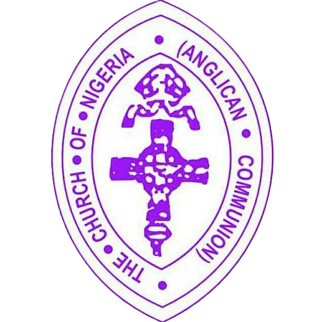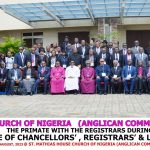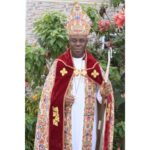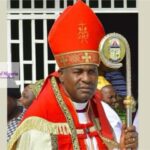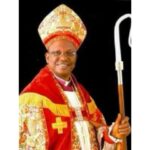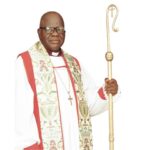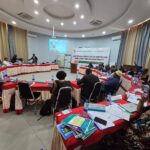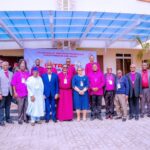- Korede Akintunde
- July 28, 2023
- 0 Comments
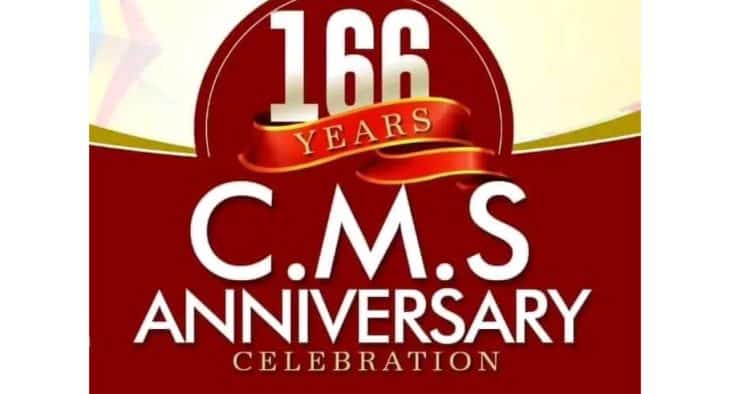
TIT BITS ON THE CMS NIGER MISSION ANNIVERSARY STORY by Ven A. I. Ibe.
Enjoy, and Appreciate Our Benefactors.
Text: Isaiah 9:2-3.
“The people walking in darkness have seen a great light; on those living in the land of the shadow of death, a light has dawned. You have enlarged the nation & increased their joy; they rejoice before you as people rejoice at the harvest”….(NIV).
The 27th day of July every year marks the CMS Niger Mission Anniversary. 2019 is the 162nd.
We (the Anglicans, and direct beneficiaries of the first light of the gospel) usually use this period in our life as Christians to reflect on where we were, where we are now, and where we are going, even as we continue to thank God for bringing us from darkness into his marvelous light.
Please note that this write-up is not in any way near anything comprehensive on the work of the CMS in ensuring that the seed of the gospel is planted in this part of the world. It’s only a sketchy picture of what transpired in those “yesteryears.”
After many unsuccessful attempts by the white missionaries to bring the Good News of the gospel to the countries of West Africa, converted & Christianized slaves were later drafted into the team that eventually succeeded in bringing the light of the gospel to our land. BISHOP SAMUEL AJAYI CROWTHER (a Yoruba freed slave who schooled in Fourah Bay College, Sierra Leone) was the arrowhead leader of this team.
History has it that the first missionary incursion into the coast of West Africa was pioneered by the Portuguese in the 15th century, the principal initiator being a popular prince known as Henry the Navigator. However, the endeavor did not record much success due to many unfavorable factors. The 2nd endeavor which was initiated in the 19th century was more of a success than the first & led to the planting of enduring Christianity in many countries of West Africa.
Nigeria, & the Igbo race, in particular, benefited immensely from this. Two great events of the time contributed immensely to the success of this 2nd endeavor: the evangelical Great Awakening of the 19th century, & the abolition of the slave trade by the British Parliament in 1807. The CMS & the missionary work in this part of the world centers around Bishop Samuel AJAYI CROWTHER, the man whom God used to pioneer this work.
But Who Is This Man – Bishop AJAYI CROWTHER?
About 1806 – Born in Osoogun, in Ogun State;
1821 – Captured into slavery
1822 – Rescued & taken to Sierra Leone
1823 – Mission School Boy
1825 – Baptized
1828 – 1st Student of Fourah Bay College
1843 – Ordained Clergyman
1846 – Re-United with his mother & sister
1857 – His Missionary Team landed in Onitsha (26/27th July)
1864 – Consecrated Bishop (29th June)
31.12.1891 – Died, an accomplished Man of God.
THE CHURCH MISSIONARY SOCIETY (CMS)
The CMS was founded in 1799 for the purpose of going to spread the gospel message overseas. But the move to Nigeria was made when Henry Venn was the CMS Secretary (1841-1872). The society for the extinction of the slave trade & civilization of Africa was formed on 1st June 1840. This society brought together in Great Britain those who were interested in Africa & acted as a pressure group on the government.
ADVENT OF CHRISTIANITY IN NIGERIA.
As mentioned above, the result of the pressure on the Government was the 1841 expedition in which three ships were sent to the Niger, the mouth having been discovered by Richard Lander. Among the members of the Niger expedition were Rev. J.F. Scion, a German missionary of the CMS, & a young Catechist, the freed slave, Samuel AJAYI CROWTHER, and Simon Jonas, among others. They introduced trade and model farms as well as Christianity. In Freetown, Sierra Leone there were former slaves who were familiar with the language of the Niger area. They were drafted to join the team.
In 1857 Rev S. A. CROWTHER led the CMS team for the Niger Expedition. With him were Rev. J.C. Taylor, Catechist Simon Jonas, & Augustus Armadillo, all of them Igbo ex-slaves resident in Sierra Leone. The team landed in Onitsha on 26/27th July 1857 & were welcomed by the then Obi Akazua of Onitsha, his son Odili & the rest of the Onitsha people. The Niger mission was thus founded. They requested land to establish their mission & were gladly given the land area from around the former ABS (now Shoprite) down to the River Niger, (around Ose Okwuordu). This is the root of our celebration of the CMS NIGER MISSION Anniversary every 27th July.
Our sister denomination, The Roman Catholic Mission (RCM) arrived in Onitsha much later in 1885 (28yrs later) & requested the land from the Onitsha people. They were referred to the CMS people who gladly welcomed & accommodated them, & released to them as much land as they requested. Such places included Holy Trinity area and Sacred Heart, Odoakpu areas. (May the accommodating spirit of our fathers continue to guide us).
The actual work of evangelism & planting of Christianity in IGBOLAND was spear-headed by Rev. J.C. Taylor. Crowther only played a supervisory role. For the mission in Onitsha, & indeed Igboland, to succeed they insisted on the study of the language of the people & the coining of the Igbo alphabet, as this would enhance the relationship between the missionaries and the people of the land. Again it will enable Taylor to teach, and reach out through visits and conversations.
The first achievement of the CMS missionaries was the coining of the Igbo alphabet. They tried to formulate it alongside the English alphabet but some Igbo accents could not be found in the English alphabet. This led to having such compound letters as gb, gh, kp, sh, ch, gw, kw, nw, & ny. There are also the letters ‘n’ with a dash or dot on the top & ‘o’ with a dash or dot at the bottom to give ‘ň’ & ‘ǫ’ respectively. Likewise, such letters as c, q, and x in the English alphabet did not find a place in the Igbo alphabet. In the end what we have below formed the foundation of the Igbo language in prints.
A a B b GB gb D d E e
F f G g GH gh H h I i
J j K k L l M m N n
N n O o O or P p KP kp
R r S s SH sh T t U u
V v W w Y y Z z CH ch
GW gw KW kw NW nw NY ny .
From this foundation, the CMS started to build the Igbo grammar by merging each consonant with each of the 6 vowels to give ba be bi bo bǫ bu, up to za ze zi zo zǫ zu. This done, they went further to three-letter words & came up with Gi na ya. O bu mu. Chia Ochi. Jee ubi. Kee Ji. Kpoor ya. Unu bia, etc.
From this stage again they went on to short stories and full-page stories. This eventually gave birth to the first ever printed book in IGBOLAND known as “Azu Ndu.” It was so called in the belief that the seed of the gospel (the Word of God) has been planted in IGBOLAND and, like every plant with green leaves, it has germinated & will continue to grow, hence the name: “AZU NDU,” meaning A Book with “Green Back Cover.” It is not “Azu Ndu” as in “Fresh Fish” as many have grossly and ignorantly misinterpreted it to mean.
After successfully printing the “Azu Ndu” the missionaries and the early “graduates” such as George Nicholas Anyaegbunam, the 1st Igbo clergyman, and many others, went ahead to work on translating the Bible into the Igbo language which has now been rooted in the land. Their efforts gave birth to a complete Igbo version of the Bible in 1913. Archdeacon Dennis of the famous DMGS played a distinguished role in the translation work and printing. There were many other people who rendered help one way or the other in this noble task to bring the Word of God in our native language to our doorsteps, & to lay the foundation of education in this part of the country.
In their bid to stop slavery & cannibalism in IGBOLAND, the missionaries traveled to different parts of the world in search of food items suitable for the West African climate, which will equally be good for African trade. The search yielded positive results in that almost all the staple food items we enjoy today were brought into the country by the CMS. The following are some of the food items & the country from where they came.
Yam: West Indies
Tomato: West Indies, USA, South America
Maize: USA, West Indies, India, & China
Cassava: Brazil, South America, & the Amazons
Plantain/Bananas: India, Cameroon, Germany
Pepper and Pineapple: India
Coconut: Honolulu
Guava: Cameroon, thru’ the Germans
Sheep & Goat: Australia, Tasmania, Argentine, & New Zealand
Fowl: Rhode Island, & Asia Minor
Rice: America, Japan, China, & Ceylon
Cocoa, Avocado, Cocoyam: India & Ceylon
Beans: Egypt, Sudan, & Americas,Etc.
With the above startling revelation, one wonders what our ancestors had for food. No wonder they killed their fellow human beings for food. We cannot really thank the missionaries of the CMS enough for the sacrifice they made to give us the light of the Gospel we enjoy today.
NOTE: This is only the tip of the iceberg.
MAY GOD IN ALL THINGS BE GLORIFIED!!!!!!!!
Hail the anniversary Day….Happy Day!!!
Join us children as we march along the way
To o o sing the anniversary song… Happy Day!!!
1-6-2 years ago we had no song like this…
But now with thankful hearts, we all can take our part
And sing the anniversary song…Happy Day!!!!!!
Happy day, great Day we thank the Lord for it.
We are rejoicing now, Rejoice, Rejoice with us
And sing the anniversary song …..
Happy Day !!!!!
Happy Anniversary celebration, everyone.
It’s now left for us to examine ourselves to see whether we’re still toeing the line of our forefathers in the sacrificial contributions they made to ensure that the seed of the gospel germinated, grew, and blossomed into the gigantic tree it is today.
Remain blessed in the Lord.
